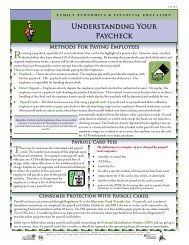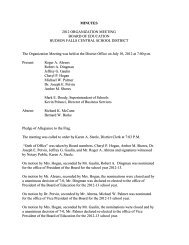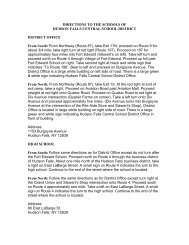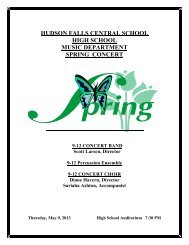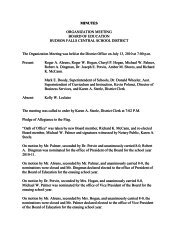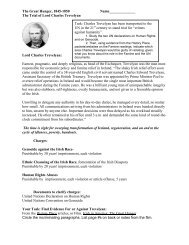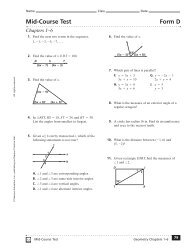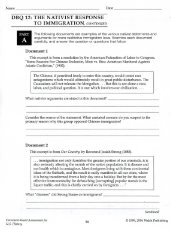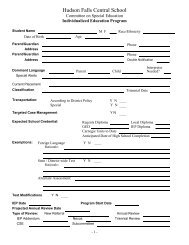Electronic Banking Lesson Plan
Electronic Banking Lesson Plan
Electronic Banking Lesson Plan
Create successful ePaper yourself
Turn your PDF publications into a flip-book with our unique Google optimized e-Paper software.
1.7.2<strong>Electronic</strong> <strong>Banking</strong>Grade Level 10-12“Take Charge of Your Finances”Time to complete: 90 minutesNational Content StandardsFamily and Consumer Science Standards: 2.4.1, 2.4.2, 2.5.4, 2.6.1National Council on Economic Education Teaching Standards: 10, 11National Standards for Business Education• Career Development:• Economics: VII.1• Personal Finance: VI.1, VI.2, VI.3-4ObjectivesUpon completion of this lesson, students will be able to:• Describe electronic banking.• Define the different types of electronic banking.• Understand how to safely use an Automated Teller Machine and debit card.IntroductionE-banking allows 24-hour access to move money electronically in a fast and paperless way. The electronic movementof money is made possible by electronic funds transfers (EFTs). EFTs utilize computer networks to transfer fundselectronically (rather than by check or cash) among various bank accounts. E-banking allows a person to makewithdrawals, deposits, and bill payments via phone, computer or through machines like an automated teller machine(ATM) or point of sale terminal (POS terminal) rather than sending cash or check via regular mail. Benefits to e-banking include:• 24-hour access;• Fast transactions;• Paperless transactions;• Convenience;• Worldwide access.A debit card is a plastic card which looks like a credit card, but is electronically connected to the cardholder’s bankaccount for purchases. When a purchase is made, money is automatically taken from the designated account. Thecard provides access to the EFT system by swiping it into an ATM or POS terminal. Debit cards require using apersonal identification number (PIN) or signature to perform transactions. A PIN or signature confirms that theuser of the debit card is authorized to access the account unless, of course, the card is stolen. A way to protect adebit card from being used by an unauthorized individual is to sign the back of the card in the signature box with“see id.” This will prompt the vendor to ask the individual to see picture identification and match the picture andname with the individual making the purchase. Debit cards can also function as an ATM card. Debit cards can beused when money is not in the account but could result in a non-sufficient funds fee. Debit-card transactions maynot clear the bank until the next business day depending upon how quickly a business processes its sales. For thisreason it is important to know your account balance prior to making a debit card purchase. Some suggest having aline of credit loan or an automatic transfer from a savings account set up as overdraft protection on your account to© Family Economics & Financial Education – Revised March 2008 – Financial Institutions Unit – <strong>Electronic</strong> <strong>Banking</strong> – Page 1Funded by a grant from Take Charge America, Inc. to the Norton School of Family and Consumer Sciences at the University of Arizona
1.7.2avoid non- sufficient funds. Depending upon the institution, a person still may be required to pay an over-draft feeissued by their depository institution, but their transaction will not bounce so the vendor will not charge a fee.With debit and ATM cards, consumers need to be alert to protect their financial security. A consumer’s PINnumber normally should not be one that reveals their birth date or social security number. Consumers should notwrite their PIN numbers down, and instead should memorize them. Consumers are responsible to report anyunauthorized activity to their depository institution immediately. According to the Federal Trade Commission, aconsumer is held liable for any unauthorized charges under the following conditions: 1o If timely notice is given of a loss or theft to the depository institution within two business days, theconsumer is held responsible for no more than $50.o If the depository institution is not notified within the first two business days but is notified within the first60 days, the consumer is held responsible for no more than $500o If the depository institution is notified after 60 days of the transmittal of the periodic statement, theconsumer is held liable for no more than the amount of unauthorized transfers.Automated teller machines (ATMs) are electronic computer terminals which offer automated, computerizedbanking. ATMs allow customers to make deposits, cash withdrawals, account transfers, and check account balances.ATMs can be found in a variety of places including supermarkets, depository institutions, shopping malls, and otherconvenience stores. ATMs are accessed with an ATM or debit card and a PIN. Fees may be charged for ATM use,but will vary depending on the particular depository institution. Another type of electronic computer terminal is apoint-of-sale (POS) terminal. The POS terminal is located at a store and allows the customer to use a debit cardto make a purchase. A debit card’s magnetic strip will be swiped through a machine by either the customer or salesassociate. The customer will then select either debit or credit. If a debit is selected, then a pin number will berequired to authorize the transaction. The debit card may only be processed as a credit transaction if the debit cardis associated with a credit card company. Once the magnetic strip has been swiped, the customer’s financialinformation linked to this card will be processed by the store and the purchase will be completed. If the purchaseamount does not exceed $25.00, a signature may not be required. At participating POS machines, customers mayrequest additional cash back. Amounts vary depending upon merchant or card policies.Direct deposit allows paychecks and benefit checks to be directly deposited into a specified depository institutionaccount (usually checking or savings). For example, the customer may sign an authorization form to allow his or heremployer to automatically deposit a paycheck. Direct payments authorize bills to be paid by a specified depositoryinstitution account. This can be done for fixed expenses like mortgages or vehicle payments and for flexible expenseslike the phone or electricity bill. Direct deposit and payments are a safe way to complete transactions. Theconsumer does not handle the check and he or she will know exactly when the money will either be deposited andavailable for use or when the vendor will receive payment for the bill. Consumers are responsible for frequentlychecking their account to ensure that the correct amount was withdrawn.Another option for paying employees through the electronic banking system is by utilizing payroll cards. Payrollcards offer an alternative to printing and mailing paycheck to employees. Payroll cards function in a similar way asdebit cards. An employee’s wages are transferred to the payroll card. This is often linked to a credit card company,allowing the employee to withdraw money from the ATM or use it at a POS to purchase goods and services. 2Consumers must be aware that payroll cards are not linked to a depository institution account. Therefore,individuals do not receive the same benefits from depository institutions.Check Clearing for the 21 st Century Act (Check 21) represents a current trend in EFT that is changing bankingdramatically. Prior to Check 21, a customer would write a check to pay for a service or product, and have severaldays before the money would transfer from the customer’s account to the service provider’s account. The time© Family Economics & Financial Education – Revised March 2008 – Financial Institutions Unit – <strong>Electronic</strong> <strong>Banking</strong> – Page 2Funded by a grant from Take Charge America, Inc. to the Norton School of Family and Consumer Sciences at the University of Arizona
1.7.2between when a person writes a check to when the money is actually withdrawn is called float time. Float timeallows a person to write a check even though there is not enough money in the account, in hopes of depositing themoney before the check is processed. Because of Check 21, the check is sent electronically to the customer’sdepository institution and the money is withdrawn within hours of the transaction, therefore, eliminating most or allfloat time. Check 21 has made is possible for writing a check to be processed as quickly as using a debit card.A Pay by Phone System allows the consumer to call a vendor with instructions on how to pay their bills byelectronically transferring funds between accounts. The consumer is often required to have a written agreement withthe institution to make transactions such as these.<strong>Electronic</strong> <strong>Banking</strong> offers many options for consumers to use when managing money. Permitting banking to becompleted in a paperless process 24 hours a day is an attractive benefit to many consumers. Because of thesebenefits, the popularity of electronic banking continues to grow, encouraging individuals to learn the detailsregarding this type of financial management.In this lesson, participants will have the opportunity to increase their knowledge of electronic banking vocabularythrough an active reading strategy. In addition, they will apply their knowledge by creating an opportunity forothers to learn about electronic banking by creating a top ten poster.Body1. Hand out the <strong>Electronic</strong> <strong>Banking</strong> Scenario worksheet 1.7.2.A22. Instruct participants to complete the following with their <strong>Electronic</strong> <strong>Banking</strong> Scenario worksheet 1.7.2.A2a. Each of the following should be done with a different colored pencil.i. Instruct participants as they read to circle any vocabulary words. If they know thedefinition of the vocabulary words, instruct them to write the definition in the box to theright of the scenario. Correct definitions will be written on their <strong>Electronic</strong> <strong>Banking</strong> notetaking guide 1.7.2.L1 during the <strong>Electronic</strong> <strong>Banking</strong> PowerPoint presentation 1.7.2.G1ii. Instruct participants as they read to underline safe banking practices using a differentcolored pencil and record them in the box to the right of the scenario.iii. Instruct participants to put a box around unsafe banking practices using a different coloredpencil and record them in the box to the right of the scenario.3. Instruct participants to keep their <strong>Electronic</strong> <strong>Banking</strong> Scenario worksheet 1.7.2.A2 in front of themthroughout the PowerPoint presentation 1.7.2.G1.4. Hand out the <strong>Electronic</strong> <strong>Banking</strong> note taking guide 1.7.2.L1 and instruct participants to complete it duringthe <strong>Electronic</strong> <strong>Banking</strong> PowerPoint presentation 1.7.2.G15. During <strong>Electronic</strong> <strong>Banking</strong> PowerPoint presentation 1.7.2.G1, explain the information necessary forunderstanding the features of electronic banking.a. Slide 1: Introductionb. Slide 2: <strong>Electronic</strong> <strong>Banking</strong>i. Ask participants to discuss which electronic banking methods did Sara use?1. Answers should include:a. Phoneb. Automated teller machinec. Slide 3: <strong>Electronic</strong> <strong>Banking</strong> Benefitsi. Ask participants to discuss what benefits Sara experienced because of electronic banking.1. Answers could include:a. 24 hour access – Sara visited her automated teller machine on a Saturday.© Family Economics & Financial Education – Revised March 2008 – Financial Institutions Unit – <strong>Electronic</strong> <strong>Banking</strong> – Page 3Funded by a grant from Take Charge America, Inc. to the Norton School of Family and Consumer Sciences at the University of Arizona
1.7.2b. Fast transactions – Sara was able to stop quickly and withdraw moneyfrom the automated teller machine to meet her friends on time thatafternoon.c. Convenience – Sara was able to stop at an automated teller machine on theway to the mall.d. Slide 4: Debit Cardsi. Ask participants to discuss when Sara’s debit card was used.1. Answers could include:a. When Sara loaned her debit card to Nick so he could borrow money fromher.b. When Sara stopped at the automated teller machine on the way to the mallto withdraw money.i. Discuss with participants why Sara may not have received anaccurate balance at the automated teller machine when shewithdrew money with her debit card.1. A debit card transaction may take more then one businessday to clear. For example: if Sara made a purchase onFriday evening when she went to the automated tellermachine, on Saturday afternoon that transaction may nothave cleared her account giving her the impression she hasmore money available than she really does.c. When Sara called the cell phone company to pay her bill over the phone.e. Slide 5: Personal Identification Numbersi. Ask participants to discuss when Sara used her PIN.1. Answers should include:a. Sara gave Nick her PIN so he could access her account.b. Sara used her PIN when she stopped at the ATM on the way to the mall.f. Slide 6: Consumer Liabilityi. Ask participants to discuss what situation Sara allowed to occur that could have put herfinancial information in danger.1. Answers could include:a. When Sara loaned her debit card and personal identification number to afriend. If he would have lost the information, her information could havebeen given to someone who was not authorized to access her account.b. When Sara decided to call the cell phone company in a busy mall, givingher information over the phone to pay for her bill.g. Slide 7-8: Automated Teller Machinesi. Ask participants to identify when the Sara’s account was accessed through an ATM.1. Answers could include:a. When Nick used her debit card at the ATM the night before.i. Discuss with participants that Nick used it at an ATM because hewould not have to sign anything for the transaction to occur.b. Sara used her debit card at the ATM on the way to the mall to meet herfriends.c. Sara withdrew money from her checking account.d. Sara confirmed her paycheck was deposited from the day before.h. Slide 9: Point of Sale Terminali. Discuss with participants that at a point of sale terminal, a signature may be required.© Family Economics & Financial Education – Revised March 2008 – Financial Institutions Unit – <strong>Electronic</strong> <strong>Banking</strong> – Page 4Funded by a grant from Take Charge America, Inc. to the Norton School of Family and Consumer Sciences at the University of Arizona
1.7.2.L1Note taking guide<strong>Electronic</strong> <strong>Banking</strong>Total Points Earned22 Total Points PossiblePercentageName_________________Date_________________Class ________________<strong>Electronic</strong> Fund TransferE—banking allows aperson to makewithdrawals, deposits,and bill payments by oneof these methodsDebit Cards -Personal Identification Numbers (PIN) -According to the Federal Trade Commission, a consumer is held liable for anyunauthorized charges under the following conditions:If timely notice is given of lost or theft to the depository institution within two business days, aconsumer is liable for no more than ______________________.If the institution is not notified within the first _______business days, but within 60 days, theconsumer is held liable for no more than ____________.If the institution is notified after _________days, then the consumer is held liable for no morethan the amount of the unauthorized transfers.© Family Economics & Financial Education – Revised March 2008 – Financial Institutions Unit – <strong>Electronic</strong> <strong>Banking</strong> – Page 7Funded by a grant from Take Charge America, Inc. to the Norton School of Family and Consumer Sciences at the University of Arizona
1.7.2.L1Note taking guideAutomated TellerMachines allow thesetransactions to occur…Point of Sale Terminal -Direct Deposit—Direct Payment—Payroll Cards-Check Clearing for the 21st Century Act(Check 21) -Pay by Phone System -Float Time -© Family Economics & Financial Education – Revised March 2008 – Financial Institutions Unit – <strong>Electronic</strong> <strong>Banking</strong> – Page 8Funded by a grant from Take Charge America, Inc. to the Norton School of Family and Consumer Sciences at the University of Arizona
1.7.2.A1Worksheet<strong>Electronic</strong> <strong>Banking</strong>Total Points Earned22 Total Points PossiblePercentageName_________________Date_________________Class_________________Directions: Match the following terms with the statements below. Each question is worth 1 point.1.____ A plastic card that looks like a credit card but iselectronically connected to the card holder’s depository institution.2.____ Allows a person to write a check even though there isnot enough money in the account in hopes of depositing theA. Float Timemoney before the check is processed.B. Pay By Phone SystemC. Direct Deposit3. ____ Personal identification number required for D. Debit Carddebit cards to be used.E. Direct PaymentF. PIN4.____ This allows the consumer to call a company withG. Point of Saleinstructions to pay certain bills or electronically transferTerminalfunds between accounts.5.____ Allows paychecks and benefit checks to be directlydeposited into a specified depository institution account.6.____ Authorize bills to be paid by a specific depository institution account.7.____ An electronic computer terminal located at the checkoutof a store, allowing the consumer to use their debit cardto make purchases.Directions: Circle True or False for the following statements. Each question is worth 1 point.8. T or F ATMs can only be found at the depository institution locations9. T or F E-banking allows individuals to deposit money, withdraw money, and pay bills.10. T or F A drawback to <strong>Electronic</strong> <strong>Banking</strong> is that it may only be done using the World Wide Web.11. T or F A payroll card is an alternative for employee’s paychecks to be deposited.12. T or F When a customer uses a POS, they may request the cashier to give them cash back.© Family Economics & Financial Education – Revised March 2008 – Financial Institutions Unit – <strong>Electronic</strong> <strong>Banking</strong> – Page 9Funded by a grant from Take Charge America, Inc. to the Norton School of Family and Consumer Sciences at the University of Arizona
1.7.2.A2WorksheetScenarioIt is 9:30am and Sara’s phone rings. She quickly answers to make planswith her friends for a Saturday afternoon shopping trip. As she dresses, shebegins to contemplate about how she will pay for her purchases that afternoon.She knows that she could use her debit card in the automated teller machine (ATM)Name___________________Date____________________Class___________________Vocabulary Wordson the way to the mall to get cash or use the point of sale terminals at the stores once shearrives. However, she gave her debit card and personal identification number to her friendNick yesterday so he could borrow money from her. So, her first step is to retrieve the cardfrom Nick.Sara contacts Nick and receives her card. She decides to stop at the ATM on theway to the mall so she can check her account balance to ensure her paycheck was directlydeposited the day before. Sara’s employer gave her the option of using a direct deposit intoher checking account or a payroll card. She was not familiar with a payroll card so sheSafe <strong>Banking</strong>Practicesdecided to utilize the direct deposit option. In addition, she pays many of her bills usingdirect payment. With all of the deposits and payments happening through one account, it isconvenient for Sara to track her transactions. Sara no longer uses a check book because shefound it difficult to record the checks in her register. Also, with the float time non existentbecause of Check 21, it is not a benefit for Sara to use her checkbook.Sara meets her friends, but before they begin shopping she realizes she forgot topay her cell phone bill prior to leaving home. She is happy that her cell phone companyallows a pay by phone option. Using her debit card, she calls and makes the payment overthe phone.Unsafe <strong>Banking</strong>PracticesFinally, after taking care of her financial transactions, she begins an afternoon ofshopping with her friends.© Family Economics & Financial Education – Revised March 2008 – Financial Institutions Unit – <strong>Electronic</strong> <strong>Banking</strong> – Page 11Funded by a grant from Take Charge America, Inc. to the Norton School of Family and Consumer Sciences at the University of Arizona
1.7.2.J1To facilitate the trivia game:<strong>Electronic</strong> <strong>Banking</strong> TriviaInstructions1. Set up the LCD projector and laptop with the <strong>Electronic</strong> <strong>Banking</strong> Trivia PowerPoint presentation 1.7.2.G2.2. Divide the participants into groups of 3 – 4.a. Hand out pieces of scratch paper and a marker to each team or a white board with a dry erasemarker.3. Each team will have a chance to answer each question by writing their answer on the scratch paper.a. After the facilitator has given a little bit of time for each team to record their answer, ask each groupto hold up their answer.b. Award points to the groups with the right answers.i. Teams with the wrong answers do not receive or lose any points. Their point total stays thesame.c. Record the points on the board.4. Allow each team to take a turn picking the category and dollar amount for the question.a. The facilitator can decide how to let each team take turns choosing.5. To use the PowerPoint:a. On the first slide, click on the graphic to get to the activity board slide.b. To choose a question, click on the category and dollar amount chosen.i. It is linked to the question slide and will automatically pull up the correct slide.c. After reading the question and the groups have all answered, click on the graphic directly under it togo to the answer slide.d. After the question and answer is finished, click on the graphic below the answer to go back to theactivity board.e. At the activity board, if the wrong category or dollar amount is chosen, the little graphic in the lefthandcorner of any question slides will take the screen back to the activity board.6. Before final trivia, compute the point total for each team.a. Allow each team to decide a ‘wager’ before answering the final trivia question.b. If the final trivia question is answered correctly, the wager is added to the points.c. If the final trivia question is answered incorrectly, the wager is subtracted from the points.7. The team with the most points wins.© Family Economics & Financial Education – Revised March 2008 – Financial Institutions Unit – <strong>Electronic</strong> <strong>Banking</strong> – Page 13Funded by a grant from Take Charge America, Inc. to the Norton School of Family and Consumer Sciences at the University of Arizona



